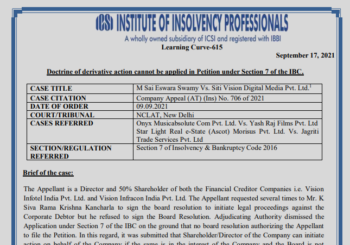Study Notes - Change in Object Clause
June 19, 2020
The procedure for change in object clause is as follows:
- Step 1: First call a board meeting for approval of change in object clause. The agenda of the board meeting will be to approve the change in object clause and to call an EGM to get the shareholder’s approval for change in object clause.
The board meeting should be called by giving at least 7 days notice.
The board will determine the changes in the object clause and will set the agenda for EGM.
The board will approve notice for calling EGM by fixing date, time and venue of EGM.
Sample Board Resolution:
Change in Object Clause of the Company
“RESOLVED THAT pursuant to the provisions of Section 13 and other applicable provisions, if any, of Companies Act, 2013, (including any statutory modifications or re-enactment thereof, for the time being in force), and the rules framed there under, consent of the Board of Directors of the Company be and is hereby accorded, subject to the approval of the Registrar of Companies, NCT of Delhi & Haryana and subject to the approval of Shareholders in General Meeting, to append following sub clause (3) after sub clause (2) of clause III (A) of the Memorandum of Association of Company:
(4) “To carry on the Business of ………”
FURTHER RESOLVED THAT for the purpose of giving effect to this resolution, _____________, Director of the Company be and is hereby authorized, on behalf of the Company, to do all acts, deeds, matters and things as deem necessary, proper or desirable and to sign and execute all necessary documents, applications and returns for the purpose of giving effect to the aforesaid resolution along with filing of necessary E-form as return of appointment with the Registrar of Companies, NCT of Delhi and Haryana.” - Step 2: The second step after the Board Resolution is to issue notice of Extraordinary Meeting to all Members, Directors and the Auditors of the company in accordance with the provisions of Section 101 of the Companies Act, 2013.
The Notice contains the date, time and venue of the EGM. The notice will be accompanied by an explanatory statement detailing the reasons for change in object clause. Interest of the director in the resolution should be disclosed in the explanatory statement. The Notice shall be issued at least 21 clear days before the EGM. - Step 3: The third step is to hold an Extraordinary General Meeting at the time, place and venue as given in the notice and to pass the necessary Special Resolution under section 13(1) of the Companies Act, 2013, for change in object clause of Memorandum.
Sample Shareholders Resolution:
Change in Object Clause of the Company
“RESOLVED THAT pursuant to the provisions of Section 13 and other applicable provisions, if any, of Companies Act, 2013, (including any statutory modifications or re-enactment thereof, for the time being in force), and the rules framed there under, consent of the shareholders of the Company be and is hereby accorded, subject to the approval of the Registrar of Companies, NCT of Delhi & Haryana, to append following sub clause (3) after sub clause (2) of clause III (A) of the Memorandum of Association of Company:
(4) “To carry on the business of…….”
FURTHER RESOLVED THAT for the purpose of giving effect to this resolution, __________, Director of the Company be and is hereby authorised, on behalf of the Company, to do all acts, deeds, matters and things as deem necessary, proper or desirable and to sign and execute all necessary documents, applications and returns for the purpose of giving effect to the aforesaid resolution along with filing of necessary E-form as return of appointment with the Registrar of Companies, NCT of Delhi and Haryana.” - Step 4: Once the necessary special resolution is passed at the EGM, the company needs to file the special resolution with the Registrar within 30 days of passing the resolution. Form MGT-14 is required to be filed for filing the resolution with the Registrar. Form MGT-14 contains details about the special resolution passed.
Attachments with form MGT-14- Certified copy of the resolution
- Notice of Extra ordinary General Meeting (EGM)
- Explanatory statement to the notice
- Altered Memorandum of Association
- Step 5: Registration of change in object clause by the Registrar
As per section 13(10), no alteration made under this section shall have any effect until it has been registered in accordance with the provisions of this section.
As per section 13 (9) The Registrar shall register any alteration of the Memorandum with respect to the objects of the company and certify the registration within a period of thirty days from the date of filing of the Special Resolution in accordance with clause (a) of sub-section (6) of this section.
Therefore once, form MGT-14 is filed, the Registrar will examine the form and register the change in object clause by issuing a fresh certificate of incorporation. - Main objects
- Incidental and ancillary objects and
- Other objects
- THE OBJECTS TO BE PURSUED BY THE COMPANY ON ITS INCORPORATION i.e Main Objects.
- MATTERS WHICH ARE NECESSARY FOR FURTHERANCE OF THE MAIN OBJECTS.
- To amend the title of incidental object Clause of the Memorandum Of Association by passing the following resolution:
“Clause III (B) of the objects that are incidental or ancillary to the attainment of the main objects of the Memorandum of Association be and hereby replaced with the title “MATTERS WHICH ARE NECESSARY FOR FURTHERANCE OF THE OBJECTS SPECIFIED IN CLAUSE III (A) ARE:-“ - To Delete the other objects clause of the Memorandum Of Association by passing the following resolution:
“Pursuant to the provisions of Section 4, 13 and all other applicable provisions, if any, of the Companies Act, 2013, (including any amendment thereto or re-enactment thereof), and subject to necessary approval(s) if any, from the competent authorities, the Other Objects Clause of the Memorandum of Association of the Company be removed by completely deleting the clause III (C)”.
-
Another important point to remember
Here another thing to be kept in mind while altering the Object clause of Memorandum is that the Registrar may ask for adoption of new set of memorandum and articles in line with the new Companies Act’2013.
The statutory backing for adopting new set of memorandum and articles is given in Section 6 of the Companies Act’2013 which is given as follows:
“(b) Any provision contained in the memorandum, articles, agreement or resolution shall, to the extent to which it is repugnant to the provisions of this Act, become or be void, as the case may be.”
Therefore, the provisions under the old memorandum/articles may be repugnant i.e contradictory/inconsistent with the provisions of the Companies Act’2013 and hence may be termed as void therefore it is advisable to adopt new set of memorandum and articles as per Companies Act’2013.
Major reason for that is the change in format of Memorandum and articles under the previous act and the new act’2013.
Major difference between the memorandum under Companies Act’1956 and 2013 is the object clause. While the Object clause under the 1956 Format included three sub-clauses:
The format under the Companies Act’2013 includes only two sub clauses:
Therefore while altering the object clause it is advisable for the company:
ADOPTION OF NEW SET OF ARTICLES OF ASSOCIATION
Pursuant to the provisions of Section 14 and other applicable provisions, if any, of the Companies Act, 2013, (including any amendment thereto or re-enactment thereof), the Articles of Association of the Company should be altered thereby replacing all the existing regulations with the new regulations
Disclaimer
All academic material provided in this website by way of quiz or otherwise is derived from various sources, reference of which is given below. The objective is to provide such information or exercises is purely for academic purpose. MPPL is not the creator of such information since they are derived from the statutes, laws, rules, regulations, notifications or circulars issued by the government authorities or judgments of courts of law under relevant laws. While MPPL is only collating such information, it does not claim any exclusive copyright thereon except the manner in which it is being presented. The user understands that some situational questions can have different views and opinions which may not necessarily match with what the answer keys provide. MPPL does not vouch for or guarantee the accuracy or dependability of the answer key. Nor shall it be liable for any suits, prosecution, proceedings, actions, damages based on the academic information provided here. The responsibility to cross-check and verify the veracity of the information provided here rests upon the user and visitor of the website.
MPPL has taken all reasonable precautions for not violating anyone else’s copyright or intellectual property right and believes. However, in case someone still feels that any of the content provided here was subject to their copyright, such person is requested to get in touch with MPPL on its email id a pratima@mangalamjobs.com and necessary remedial measures can be undertaken without prejudice to MPPL.


